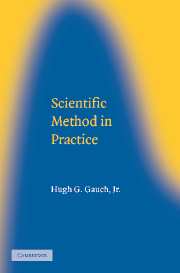Book contents
12 - CONCLUSIONS
Published online by Cambridge University Press: 05 March 2015
Summary
In two words, the business of scientific method is theory choice – the choice of what to believe about the physical world. The presuppositions, evidence, and logic that comprise the scientific method have been explored in earlier chapters. Here a brief overview will draw much from the insightful and concise account of scientific method by Box et al. (1978:1–15).
Figure 12.1 shows the basic elements of data collection and analysis in scientific research. Starting at the top of this figure, the object under study is some part of the natural world. The scientist's objective is to find the truth about this physical thing, as emphasized in Chapter 2. The currently favored hypothesis Hi regarding this object will influence the design of a relevant experiment to generate empirical observations. When designing an experiment, a scientist must consider the prospective value of its data for discriminating between the competing hypotheses, together with the experiment's cost and risk. Informative experiments concentrate attention on situations for which the competing hypotheses predict different outcomes.
Naturally, different scientists may choose different research strategies: “Notice that, on this view of scientific investigation, we are not dealing with a unique route to problem solution. Two equally competent investigators presented with the same problem would typically begin from different starting points, proceed by different routes, and yet could reach the same answer. What is sought is not uniformity but convergence” (Box et al. 1978:5).
- Type
- Chapter
- Information
- Scientific Method in Practice , pp. 406 - 409Publisher: Cambridge University PressPrint publication year: 2002



